The trek to Everest Base Camp has finally come to a close. I have saved my favorite part for the last installment.
Speaking of last installments, this will also be my final blog post. I will discontinue this site, for now. As it turns out, I am busier in “retirement” than I thought I would be and I am unable to give enough time and devotion to this blog that it deserves. Thank you all for your support and comments over the past two and a half years!
The clang of yak bells along the hike always lifted my spirits every time. Yak bells is an age-old sound of a way of life unique to the Himalaya. Yak herding was a tradition of the original Sherpa people when they from Tibet which makes it one of the oldest occupations. The yaks in their herds have been domesticated from wild herds, some of which still exist in the far corners of Tibet.
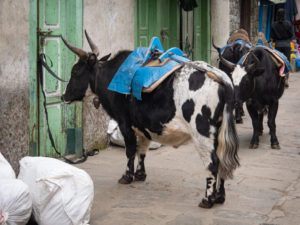 However, I need to make something clear: there are two types of yaks. The pure breed and the crossbreed. The zhokpa is yak crossed with cattle as seen here. The difference is clear once you’ve seen both but what drew me to them wasn’t their genetics but the bells they wore. They wore larger, deeper sounding bells than the sleigh bells of the horses and the music they created made my heart sing.
However, I need to make something clear: there are two types of yaks. The pure breed and the crossbreed. The zhokpa is yak crossed with cattle as seen here. The difference is clear once you’ve seen both but what drew me to them wasn’t their genetics but the bells they wore. They wore larger, deeper sounding bells than the sleigh bells of the horses and the music they created made my heart sing.
The yaks, due to their centuries of evolution, do exceptionally well at higher altitudes due to their fur (can withstand temps up to 40 below!) and extra large lung capacity. Therefore, you will see zhokpa at the lower elevations and yaks in the upper elevations. Here is a white zhokpa and below it are two images of yaks.
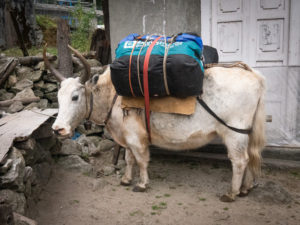
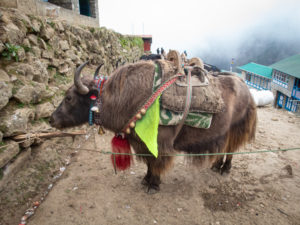 These are yaks.
These are yaks. 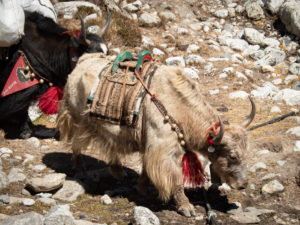
Owning a herd of yaks is a goal of many in the Khumbu Region as it is seen as a status symbol, and being a herdsman is a respected occupation. The number of yaks in a man’s herd represents his wealth.
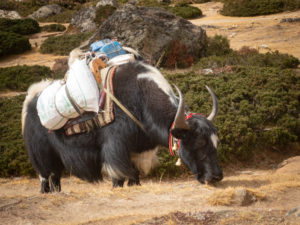
Yaks supply transport, milk, protein, fur, hoof, dung, bone, skin, and tail. Tea is made with yak milk and is a staple part of the diet of yak herders. Yaks convert the sparse grass of this highland into clothing, butter for tea, fuel for the stove, and meat on the fire. Herding, in addition to small scale agriculture and trade with Tibet and lower foothills, enabled the Sherpa to live in this land of rock, ice and snow.
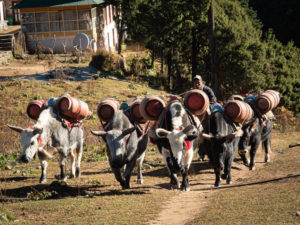
This is a zhokpa train coming through Tengboche.
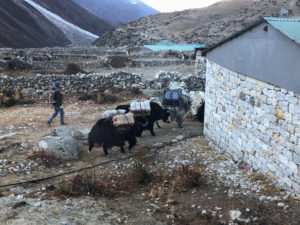
I tried to input video so you could hear the bells but technology wasn’t cooperating. Here’s the explanation: We woke up one morning to yak bells and whistles. This herder was getting his train moving early one morning, right outside our window! I was awake enough to grab a camera and video it. Unfortunately, all you get is the still image.
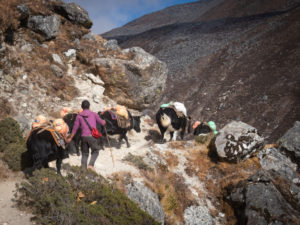
Running into yak or zhokpa trains was common and happened several times a day. The narrow paths made some encounters tricky as their horns came quite close to us. Goring us on purpose was never a concern but accidents DO happen. I had a video of a horn clipping one of Elen’s hiking poles on one such narrow path and me having to dodge the horn while filming!
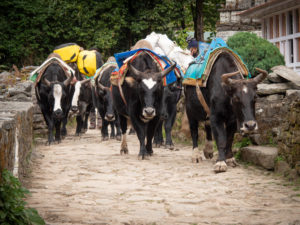
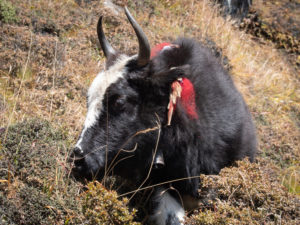 Like the horses, many of the yaks and zhokpas were decorated.
Like the horses, many of the yaks and zhokpas were decorated.
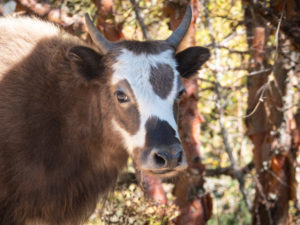
This baby was hanging out in a village we passed through and the babies below appear to be in training as they follow a yak herd down the trail. Baby yaks are fully independent at one year old but not full grown until seven or eight years old.
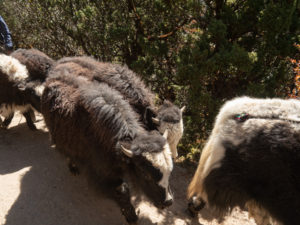
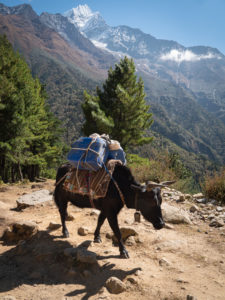 Can you tell? Zhokpa or Yak?
Can you tell? Zhokpa or Yak?
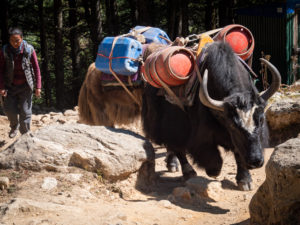 I love this image because it looks like we’re being charged by a crazy yak! We’re not. These animals are very sure-footed.
I love this image because it looks like we’re being charged by a crazy yak! We’re not. These animals are very sure-footed.
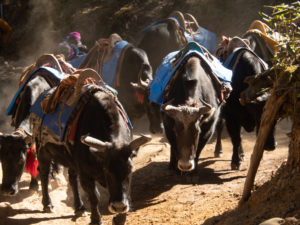 A herd of zhokpa coming our way, can you hear the bells?
A herd of zhokpa coming our way, can you hear the bells?
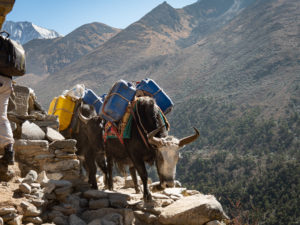 Our guide drilled into our heads to always take the inside track when passing or being passed by anything, human or animal. This trail section has a Grand Canyon feel.
Our guide drilled into our heads to always take the inside track when passing or being passed by anything, human or animal. This trail section has a Grand Canyon feel.
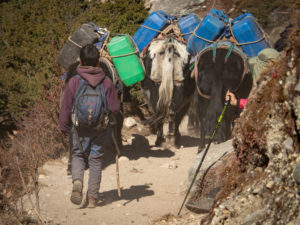 Some of the yak herders were quite young.
Some of the yak herders were quite young.
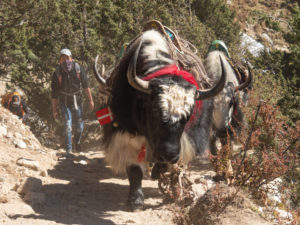
They moved slow enough that I could get in front of them, shoot and still have plenty of time to get out of the way.
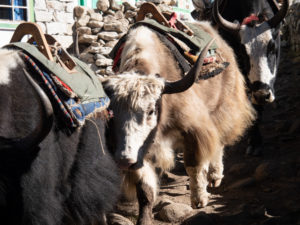
So that’s it! Thank you for joining me on our journey to Everest Base Camp and my journey as a blogger, it’s been fun and I really appreciate all of your support!
You can continue to follow my photographic adventures on my Kachina Photos FaceBook page.
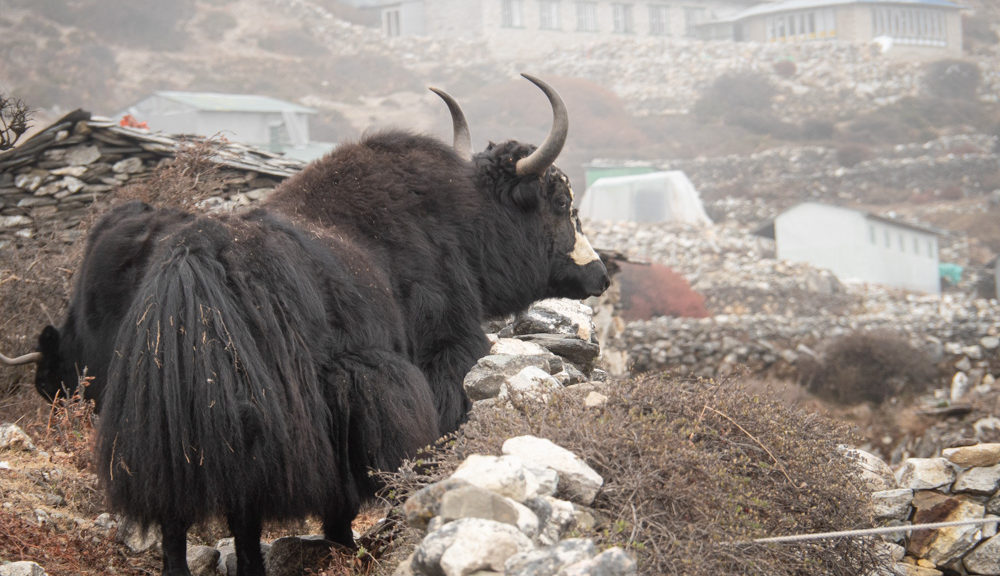
Your blogs on Everest have been wonderful to my eyes and the rest of my senses. Thank you, Vicki, for your sharing this extraordinary experience.
Vicki I’m going to miss this blog!!!! I’ve been able to travel the world through your lens! I’ve enjoyed every minute of it thanks for sharing !!
Wendy
This is my second favorite just after the horses! Really have enjoyed this blog and learned a lot, too. Your images are wonderful and inspire my own travel image making now. I’m going to miss it.
What a great finale! Though I’m going to miss your blogs – they’e the best out there. This was a particularly wonderful series, educational, fun to read, great photos and you really take your readers there.
Thank you so much Vicki! I will miss traveling with you and Ellen, just as I miss seeing your smiley faces. Sending my love to you both. Hope you will come visit us at the ranch one day.
I can see why they would be your favorite, so gentile and dependable. I’ll miss the blog, but I know about busy retirement!
Kit
Thanks for the great images.
All my best to you,
Clark